The Icing on the Cake
The Icing on the Cake
It is a pivotal point in the wedding ceremony when the knife cuts into the wedding cake, the first pieces are cut and the bride and groom serve each other symbolizing their first meal as a couple. The cake gets a lot of attention so it needs to look great and taste as good as it looks. Since you probably have little knowledge about what goes into making such a cake, here’s what you need to know before you talk to the cake designer.
A Primer on Cakes
The first image that comes to mind when you say wedding cake are multi-tiered towers with figures of the bride and groom atop. The tiered cake is still the most popular and is made by stacking progressively smaller layers on top of each other. Layers can be attached or separated by means of a firm support material such as cardboard or plastic that is set upon miniature Romanesque columns or Lucite cylinders. Separated cakes are usually taller and can require on-site construction before the reception.
The actual cake is commonly based on a traditional white-cake recipe, with or without a filling, or a fruitcake recipe if a darker, richer cake is desired. Layers do not all need to be the same. Some couples prefer to have a fruitcake for the top layer that can be easily frozen and consumed on your first anniversary. Some popular variations are carrot cake with a cream-cheese icing, butter pound cake with a fruit filling or multi-layered tortes.
For very large receptions, two cakes may be needed which can be connected with decorative items like small plastic bridges, vines and Victorian-style gates. An alternative is separate bride and groom cakes. The groom’s cake is commonly darker and richer and less formal than the wedding cake. Unusual designs and decoration are popular. Some couples like to cut it into small pieces which are wrapped or boxed separately for the guests to take as souvenirs. It was thought that a woman slipping a piece of this cake under her pillow, will dream of her future husband.
Here are some of the most popular methods of decorating wedding cakes.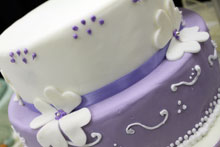
- Butter cream – a traditional icing that is easily piped to create realistic flowers and ornamental details. It takes flavors and liquors well.
- Drage´ es – gold or silver balls of candied sugar.
- Gold and silver leaf – commonly used as a final touch to highlight flowers and details. It is edible but can be expensive.
- Fondant – it is smooth, cuts very clean and doesn’t dry hard. It’s easy to work with, and is suitable for all types of cakes. This type of icing also seals the cake, and prevents it from losing its moisture. Once covered, the cake can be decorated immediately.
- Marzipan – ground almond paste that can be rolled and applied like fondant and hand molded.
- Modeling chocolate – similar to gum paste but stays pliable and can be applied like fondant. Chocolate can be easily molded into decorations – both light and dark.
- Pastillage or gum paste – a standby for creating realistic flowers and decorations and although edible, hard and suggested primarily for visual rather than edible appeal.
- Pulled sugar – melted sugar syrup pulled into bows and flowers.
- Spun sugar – caramelized sugar that is “thrown” to create lace patterns.
Flowers, sculpted from sugar or cake icing is a common decorative touch. As an alternative, try candied flowers or rose petals. Designers usually insist that anything placed on the cake be edible and is a point of caution. Anything not edible should be removed prior to serving, especially for children who may not know the difference.
The finishing touch to the cake is the topper, a plaster statue of the bride and groom, an arch or other decorative element placed on the top of the cake. You can do without it or personalize it by choosing something that reflects personal interests. Mail order houses and web sites provide a wide selection and the designer may have some options of their own. The decoration of the cake is only limited by the skill and imagination of the cake designer.
If you want to break with the traditional wedding cake or just looking for something different try a tower of individual cupcakes or cream puffs stacked in the shape of a Christmas tree. If your concern is more with serving a delightful dessert consider cheesecake or an elegant Black Forest wonder.
Selecting a Cake Designer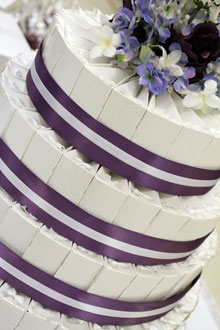
Cake designers usually have photos of past creations and can provide references to happy customers, so it’s easy to check their work. If no one specializes in wedding cakes in your area, you still have some choices. Consider using an out-of-town service and have it delivered by a guest or family member coming to the wedding. Make sure that you are the one that assesses their work and places the order. A local restaurant may have a well qualified pastry chef dying for the opportunity to show their stuff.
If a family member offers to do the job, don’t lower your expectations. Although it may be an attractive offer, be certain they are capable of the job. Even if they can bake, good ingredients are expensive so the actual savings may be much less than if you contract a professional for the job. Professionals are also better able to advise you as to what is possible. They are not likely to commit to extravagant designs that have a chance of failure and a big letdown on your wedding day.
- Explain the theme of your wedding and see what they suggest. They may have some tremendous ideas that would never have occurred to you.
- Tell the designer how many people are attending. If it is a very large reception, more than one cake may be required. Be sure they can provide for a large group.
- Ask to see photographs of their past creations. The wedding cake will draw a lot of attention so it must be both visually pleasing as well as taste good.
- Ask for referrals from other satisfied customers.
- Ask what type of cakes they specialize in. If you have an idea in mind they can tell you if it’s possible and whether they can do it. Don’t be talked out of a good idea by an unwilling designer. You may need to shop around to find the person capable of producing your unique creation.
- Ask if you may taste samples. The cake is not just a visual treat – it must look good and taste good.
- Before you ask for a quotation, know what you are asking for. Be sure to state any specific flavors or colour of decoration that you want. If you want to order other baked items, be certain to have a list compiled for your meeting with them.
- Some reception halls are able to provide the wedding cake but most will allow you to bring in your own – the best option if you want something unique.
Cake designers encourage you to bring along pictures and ideas to the first appointment. They have their own sample books that you can browse. Before they can estimate the cost, they need to know how many guests are being served, if the cake is the only dessert or part of the sweet table and if it is being served immediately after the dinner or later in the evening. These factors affect how much is consumed and subsequently the size of the cake required and the price.
Here’s how the business side works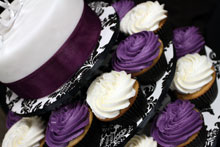
If the cake designer is popular you need to book them 6 – 12 months in advance. Cakes are made on an individual basis; nothing is prepared in advance and the cake is designed specifically to your requirements. Expect to pay a deposit when you book which varies considerably depending on the designer. It can be as low as $50 and as much 1/3 of the price of the cake. The deposit is usually non-refundable. Most businesses expect the cake to be paid for a week before the actual wedding date.
The average price for a 3-tier cake in rural areas is $300 – $400 and can be
well over a $1,000 in major centres.
Price is less dependent on the ingredients and more on the work entailed in decorating it. Chocolate has increased significantly in price making these cakes more expensive than those with vanilla flavouring. If you are concerned about cost, tell the designer. They can suggest decorations such as gum paste flowers that they order in rather than create by hand a less expensive option with the same visual affect.
The cake is baked only a couple of days before the wedding day and decorated the day before the wedding. and is carefully stored during the interim to protect the decoration and keep it fresh. Icing such as rolled fondant cannot be refrigerated and butter cream icing is very susceptible to heat. The cake designer will usually deliver the cake and set it up if the reception is local. If it is going out of town, you will need to arrange for your own transport and setup.
Tiered cakes are simply large slabs mounted on a support so they can be moved easily and lifted into place. The designer can explain the assembly method. If flowers are being used for decoration around the cake, the cake designer or florist will take on this task.
Cake at the Ceremony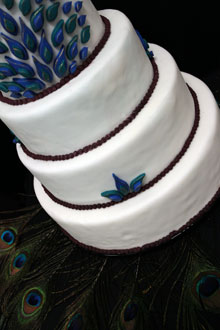
The cake cutting takes place at a strategic point in the reception, commonly an hour before you expect to leave. The MC or DJ should make an announcement to turn the guest’s attention towards the ceremony. The bride and groom cut the first slice together and offer a taste to each other. Assign the task of cutting the remainder to a guest or waiter. If you plan to use a staff person, ask if the house charges for this service – it’s not always free. Don’t forget to have someone take a picture of your cake, because there won’t be much left when your guests are through.
Tiered cakes are disassembled after the cutting ceremony and prior to serving. The suggested serving size is one by two inches, if the cake is part of the sweet table. If the cake is dessert, then two by two inch pieces are recommended. As to the actual cutting, the designer can give you some pointers on the best way, and the type of knife that should be used and may loan the knife. You can purchase knives for this purpose from gift shops and jewelers, which you may want for sentimental value. The knife is commonly decorated with artificial flowers or ribbons.
Tips & Suggestions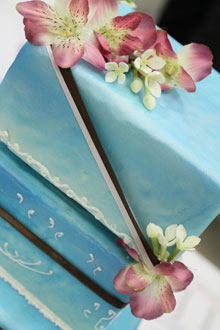
Be sure to arrange a prominent spot for the cake at the reception location so it can be seen and easily accessed for the cake-cutting ceremony. It is best not to move the cake once it is assembled. If, however, you do need move it use a secure table with casters so it can be rolled into place.
Keep the season in mind. Certain fruits may be readily available that can be used as a filling.
Humidity and heat can also adversely affect some icing types, which require the cake be kept cool and dry before the reception and displayed in the proper location. Butter cream icing will actually melt in hot weather and rolled fondant will sweat. This is especially important if you are holding an outdoor reception in summer.
Make sure you get in writing a detailed receipt describing the size, flavor, filling and decoration of the cake, if necessary, delivery date, time and address.
A multi-tiered cake is usually assembled at the reception site, rather than delivered in one piece, so make sure you have a place and time set aside for its construction.
Colour can be introduced into the cake to match the colour of the bridesmaids’ dresses or theme colour of the wedding and is usually reserved for decorative elements such as piping and flowers.
Ivory is a popular alternative to the white cake and is created by introducing a little yellow and red food colouring into the icing.
If you use flowers around the cake, try something that relates to the bridal bouquet. Make sure that flowers close to food have not been sprayed with chemicals.
Fresh fruit such as berries and grapes, coated with sugar or plain, can add a decorative and tasty accent.



























